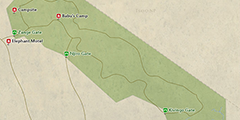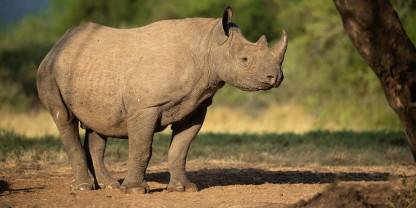Far away from any crowds, Mkomazi National Park feels wild and untrammeled. With mountains rising in every direction, the scenery is spectacular. Although wildlife is thinly distributed, all of the Big Five are present. A huge drive-in sanctuary offers a chance to get close to the endangered black rhino, which is absent or very rarely seen in most other Tanzanian parks.

-
Best Time To Go
- June to October (Animals are more easily found)
-
High Season
- This park doesn't have a high season
-
Size
- 3,245km² / 1,253mi²
-
Altitude
-
234-1,500m /768-4,921ft
 View Photos
View Photos
 View Photos
+7
Photos
View Photos
+7
Photos
 Open Map
Open Map
Pros & Cons
- Stunning scenery with views of Mt Kilimanjaro
- Off the beaten track, away from the crowds
- Big Five destination
- A chance to contribute directly to rhino conservation
- Important bird area with several northern dry-country endemic species
- Wildlife is thinly populated
- Limited game-drive circuit
Wildlife
Mkomazi shares its northern border with Kenya’s vast Tsavo West National Park and migratory herds of elephant travel between these parks in the Wet season, depending on the rainfall patterns. Dindira Dam is a good place to see a variety of thirsty animals. Coke’s hartebeest, eland, giraffe and zebra all come and go throughout the day, but if you get here in the early morning or late afternoon you might find some opportunistic lions staking out the area too.
More about Mkomazi's wildlifeScenery
Set below the slopes of the spectacular Usambara and Pare Mountain ranges and overseen by the snowcapped peak of Mt Kilimanjaro, Mkomazi has a dramatic setting and a sense of immense space. It is a classic dry-country reserve consisting of scattered gray-green scrubby bushes, interspersed with and grassland.
Activities
Aside from , activities in Mkomazi include and night drives. Not to be missed is a guided open-vehicle game drive into the 16km²/6mi² Mkomazi Black Rhino Tourist Sanctuary, where sightings of the endangered black rhino are almost guaranteed. This sanctuary opened in 2021 to allow visitors an opportunity to see rhinos that have been translocated from a long-standing breeding program based in a larger fenced sanctuary elsewhere in the park.
Weather & Climate
Typically, Mkomazi’s Dry season (June to October) is delightfully sunny and warm. It’s only at night that it gets a bit chilly. The Wet season (November to May) is hot and humid, with regular thunderstorms in the afternoons. January to February tends to be a drier spell.
More about the weather and climateBest Time To Visit
There isn’t a bad time to visit Mkomazi. The best time for wildlife viewing is generally in the Dry season, from June to October, when the vegetation is thin and animals gather around the dam. However, the scenery is most spectacular in the Wet season, from November to May, when thunderclouds bring drama to the mountainous landscape and the clear air after rainfall offers great views of Mt Kilimanjaro.
More about the best time to visit



